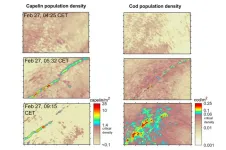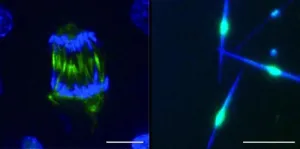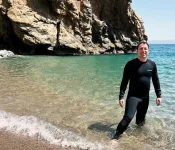(Press-News.org) There is power in numbers, or so the saying goes. But in the ocean, scientists are finding that fish that group together don’t necessarily survive together. In some cases, the more fish there are, the larger a target they make for predators.
This is what MIT and Norwegian oceanographers observed recently when they explored a wide swath of ocean off the coast of Norway during the height of spawning season for capelin — a small Arctic fish about the size of an anchovy. Billions of capelin migrate each February from the edge of the Arctic ice sheet southward to the Norwegian coast, to lay their eggs. Norway’s coastline is also a stopover for capelin’s primary predator, the Atlantic cod. As cod migrate south, they feed on spawning capelin, though scientists have not measured this process over large scales until now.
Reporting their findings in Nature Communications Biology, the MIT team captured interactions between individual migrating cod and spawning capelin, over a huge spatial extent. Using a sonic-based wide-area imaging technique, they watched as random capelin began grouping together to form a massive shoal spanning tens of kilometers. As the capelin shoal formed a sort of ecological “hotspot,” the team observed individual cod begin to group together in response, forming a huge shoal of their own. The swarming cod overtook the capelin, quickly consuming over 10 million fish, estimated to be more than half of the gathered prey.
The dramatic encounter, which took place over just a few hours, is the largest such predation event ever recorded, both in terms of the number of individuals involved and the area over which the event occurred.
This one event is unlikely to weaken the capelin population as a whole; the preyed-upon shoal represents 0.1 percent of the capelin that spawn in the region. However, as climate change causes the Arctic ice sheet to retreat, capelin will have to swim farther to spawn, making the species more stressed and vulnerable to natural predation events such as the one the team observed. As capelin sustains many fish species, including cod, continuously monitoring their behavior, at a resolution approaching that of individual fish and across large scales spanning tens of thousands of square kilometers, will help efforts to maintain the species and the health of the ocean overall.
“In our work we are seeing that natural catastrophic predation events can change the local predator prey balance in a matter of hours,” says Nicholas Makris, professor of mechanical and ocean engineering at MIT. “That’s not an issue for a healthy population with many spatially distributed population centers or ecological hotspots. But as the number of these hotspots deceases due to climate and anthropogenic stresses, the kind of natural ‘catastrophic’ predation event we witnessed of a keystone species could lead to dramatic consequences for that species as well as the many species dependent on them.”
Makris’ co-authors on the paper are Shourav Pednekar and Ankita Jain at MIT, and Olav Rune Godø of the Institute of Marine Research in Norway.
Bell sounds
For their new study, Makris and his colleagues reanalyzed data that they gathered during a cruise in February of 2014 to the Barents Sea, off the coast of Norway. During that cruise, the team deployed the Ocean Acoustic Waveguide Remote Sensing (OAWRS) system — a sonic imaging technique that employs a vertical acoustic array, attached to the bottom of a boat, to send sound waves down into the ocean and out in all directions. These waves can travel over large distances as they bounce off any obstacles or fish in their path.
The same or a second boat, towing an array of acoustic receivers, continuously picks up the scattered and reflected waves, from as far as many tens of kilometers away. Scientists can then analyze the collected waveforms to create instantaneous maps of the ocean over a huge areal extent.
Previously, the team reconstructed maps of individual fish and their movements, but could not distinguish between different species. In the new study, the researchers applied a new “multispectral” technique to differentiate between species based on the characteristic acoustic resonance of their swim bladders.
“Fish have swim bladders that resonate like bells,” Makris explains. “Cod have large swim bladders that have a low resonance, like a Big Ben bell, whereas capelin have tiny swim bladders that resonate like the highest notes on a piano.”
By reanalyzing OAWRS data to look for specific frequencies of capelin versus cod, the researchers were able to image fish groups, determine their species content, and map the movements of each species over a huge areal extent.
Watching a wave
The researchers applied the multi-spectral technique to OAWRS data collected on Feb. 27, 2014, at the peak of the capelin spawning season. In the early morning hours, their new mapping showed that capelin largely kept to themselves, moving as random individuals, in loose clusters along the Norwegian coastline. As the sun rose and lit the surface waters, the capelin began to descend to darker depths, possibly seeking places along the seafloor to spawn.
The team observed that as the capelin descended, they began shifting from individual to group behavior, ultimately forming a huge shoal of about 23 million fish that moved in a coordinated wave spanning over ten kilometers long.
“What we’re finding is capelin have this critical density, which came out of a physical theory, which we have now observed in the wild,” Makris says. “If they are close enough to each other, they can take on the average speed and direction of other fish that they can sense around them, and can then form a massive and coherent shoal.”
As they watched, the shoaling fish began to move as one, in a coherent behavior that has been observed in other species but never in capelin until now. Such coherent migration is thought to help fish save energy over large distances by essentially riding the collective motion of the group.
In this instance, however, as soon as the capelin shoal formed, it attracted increasing numbers of cod, which quickly formed a shoal of their own, amounting to about 2.5 million fish, based on the team’s acoustic mapping. Over a few short hours, the cod consumed 10.5 million capelin over tens of kilometers before both shoals dissolved and the fish scattered away. Makris suspects that such massive and coordinated predation is a common occurrence in the ocean, though this is the first time that scientists have been able to document such an event.
“It's the first time seeing predator-prey interaction on a huge scale, and it’s a coherent battle of survival,” Makris says. “This is happening over a monstrous scale, and we’re watching a wave of capelin zoom in, like a wave around a sports stadium, and they kind of gather together to form a defense. It’s also happening with the predators, coming together to coherently attack.”
The team hopes to deploy OAWRS in the future to monitor the large-scale dynamics among other species of fish.
“It’s been shown time and again that, when a population is on the verge of collapse, you will have that one last shoal. And when that last big, dense group is gone, there’s a collapse,” Makris says. “So you’ve got to know what’s there before it’s gone, because the pressures are not in their favor.”
This work was supported, in part, by the U.S. Office of Naval Research and the Institute of Marine Research in Norway.
###
Written by Jennifer Chu, MIT News
END
Oceanographers record the largest predation event ever observed in the ocean
The scientists’ wide-scale acoustic mapping technique could help track vulnerable keystone species.
2024-10-29
ELSE PRESS RELEASES FROM THIS DATE:
A molecular switch reshapes a dividing cell in minutes
2024-10-29
A living cell is a bustling metropolis, with countless molecules and proteins navigating crowded spaces in every direction. Cell division is a grand event which completely transforms the landscape. The cell starts behaving like the host of an international competition, reconfiguring entire streets, relocating buildings and rerouting its transportation systems.
For decades, researchers have been captivated by the cell's ability to organise such a dramatic transformation. Central to the process is the microtubule cytoskeleton, a network of fibres which provides structural support and facilitates movement within the cell, ensuring that chromosomes ...
Have we found all the major Maya cities? Not even close, new research suggests
2024-10-29
Using laser-guided imaging to peer through dense jungle forests, Tulane University researchers have uncovered vast unexplored Maya settlements in Mexico and a better understanding of the ancient civilization's extent and complexity.
The new research, published in the journal Antiquity, was led by Tulane University anthropology doctoral student Luke Auld-Thomas and his advisor, Professor Marcello A. Canuto.
The team used lidar, a laser-based detection system, to survey 50 square miles of land in Campeche, Mexico, an area largely overlooked by archaeologists. Their findings included evidence of more than 6,500 pre-Hispanic structures, including a previously unknown ...
Change in the law could help families of missing persons
2024-10-29
AN EXPERT on missing persons and unidentified human remains is hoping her research can help bring about a change in the law.
Work carried out by Emma Tilley, who is completing her PhD in Criminology and Policing at University of Staffordshire, is included in a Law Commission public consultation on burial and cremation.
Emma, who has starred in Locate International’s Channel 4 documentary series The Body Detectives, has been critically reviewing the cross-matching of unidentified human remains ...
Subtle eye movements optimize vision
2024-10-29
Our ability to see starts with the light-sensitive photoreceptor cells in our eyes. A specific region of the retina, termed fovea, is responsible for sharp vision. Here, the color-sensitive cone photoreceptors allow us to detect even the smallest details. The density of these cells varies from person to person. Additionally, when we fixate on an object, our eyes make subtle, continuous movements, which also differ between individuals. Researchers from the University Hospital Bonn (UKB) and the University of Bonn have now investigated how sharp vision is linked to these tiny eye movements and ...
Maternal health expert professor Vicki Clifton reveals placenta's hidden role in mental health
2024-10-29
Brisbane, Queensland, Australia (October 29, 2024) - In a revealing Genomic Press Interview published in Brain Medicine on October 29, 2024, Professor Vicki Clifton shares transformative discoveries about the placenta's unexpected influence on maternal mental health, potentially revolutionizing our understanding of pregnancy-related anxiety and depression.
Professor Clifton's team at the Mater Research Institute-University of Queensland has identified 13 distinct glucocorticoid receptor isoforms in the placenta, with one particular variant ...
From concert piano to fear memory research: Dr. Raül Andero Galí bridges mouse-human studies
2024-10-29
Barcelona, Spain (October 29, 2024) - In a compelling new Genomic Press Interview published in Brain Medicine, Dr. Raül Andero Galí reveals how his early passion for classical piano shaped his unique approach to neuroscience research. As an ICREA Research Professor at the Autonomous University of Barcelona, Dr. Andero Galí leads groundbreaking studies that connect mouse and human fear responses, potentially revolutionizing treatments for PTSD and anxiety disorders.
The intersection of stress and memory has captured Dr. Andero Galí's attention throughout his career. "All ...
Arctic whales research collaboration is signed by Heriot-Watt University and HX Expeditions (Hurtigruten Expeditions)
2024-10-29
Pioneering research to protect and conserve Arctic whale populations is to begin under a new five-year collaboration between Heriot-Watt University in Edinburgh, Scotland and HX Expeditions (Hurtigruten Expeditions), a world leader in travel exploration.
The partners have signed a five-year Memorandum of Understanding (MoU), beginning in 2024, to research challenges facing marine life in the high Arctic – the most northern part of the Arctic region and one of the world’s most fragile ecosystems.
The agreement will see Heriot-Watt University and HX work together on the Whales & Arctic Vessels Project (WAVE), ...
Scientists develop tool to predict sepsis in apparently healthy newborns
2024-10-29
A genetic signature in newborns can predict neonatal sepsis before symptoms even start to show, according to a new study.
The study, led by UBC and SFU researchers in collaboration with the Medical Research Council (MRC) Unit The Gambia, has the potential to help healthcare workers diagnose babies earlier, including in lower- and middle-income countries (LMICs) where neonatal sepsis is of particular concern. The research, published today in eBiomedicine, is funded by the National Institutes of Health and the Canadian Institutes of Health Research.
“Neonatal sepsis is caused by the body’s irregular response ...
AI algorithm accurately detects heart disease in dogs
2024-10-29
Researchers have developed a machine learning algorithm to accurately detect heart murmurs in dogs, one of the main indicators of cardiac disease, which affects a large proportion of some smaller breeds such as King Charles Spaniels.
The research team, led by the University of Cambridge, adapted an algorithm originally designed for humans and found it could automatically detect and grade heart murmurs in dogs, based on audio recordings from digital stethoscopes. In tests, the algorithm detected heart murmurs with a sensitivity ...
What animal societies can teach us about ageing
2024-10-29
Red deer may become less sociable as they grow old to reduce the risk of picking up diseases, while older house sparrows seem to have fewer social interactions as their peers die off, according to new research which shows humans are not the only animals to change our social behaviour as we age.
A collection of 16 studies, including six from the University of Leeds, have been published today as part of a special issue of the Philosophical Transactions of the Royal Society, investigating ageing and society across the natural world.
One study into red deer shows that ...
LAST 30 PRESS RELEASES:
Keck Medicine of USC names Christian Pass chief financial officer
Inflatable fabric robotic arm picks apples
MD Anderson and SOPHiA GENETICS announce strategic collaboration to accelerate AI-driven precision oncology
Oil residues can travel over 5,000 miles on ocean debris, study finds
Korea University researchers discover that cholesterol-lowering drug can overcome chemotherapy resistance in triple-negative breast cancer
Ushikuvirus: A newly discovered giant virus may offer clues to the origin of life
Boosting the cell’s own cleanup
Movement matters: Light activity led to better survival in diabetes, heart, kidney disease
Method developed to identify best treatment combinations for glioblastoma based on unique cellular targets
Self-guided behavioral app helps children with epilepsy sleep earlier
Higher consumption of food preservatives is associated with an increased risk of type 2 diabetes
NTU Singapore-led team captures first-ever ‘twitch’ of the eye’s night-vision cells as they detect light, paving the way for earlier detection of blindness-causing diseases
Global aviation emissions could be halved through maximising efficiency gains, new study shows
Fewer layovers, better-connected airports, more firm growth
Exposure to natural light improves metabolic health
As we age, immune cells protect the spinal cord
New expert guidance urges caution before surgery for patients with treatment-resistant constipation
Solar hydrogen can now be produced efficiently without the scarce metal platinum
Sleeping in on weekends may help boost teens’ mental health
Study: Teens use cellphones for an hour a day at school
After more than two years of war, Palestinian children are hungry, denied education and “like the living dead”
The untold story of life with Prader-Willi syndrome - according to the siblings who live it
How the parasite that ‘gave up sex’ found more hosts – and why its victory won’t last
When is it time to jump? The boiling frog problem of AI use in physics education
Twitter data reveals partisan divide in understanding why pollen season's getting worse
AI is quick but risky for updating old software
Revolutionizing biosecurity: new multi-omics framework to transform invasive species management
From ancient herb to modern medicine: new review unveils the multi-targeted healing potential of Borago officinalis
Building a global scientific community: Biological Diversity Journal announces dual recruitment of Editorial Board and Youth Editorial Board members
Microbes that break down antibiotics help protect ecosystems under drug pollution
[Press-News.org] Oceanographers record the largest predation event ever observed in the oceanThe scientists’ wide-scale acoustic mapping technique could help track vulnerable keystone species.







